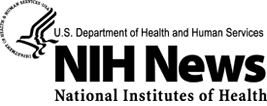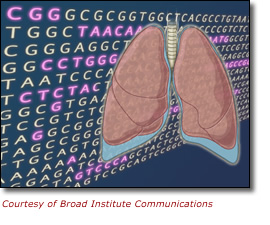Last updated: July 24, 2012
Large-Scale Genetic Study Sheds New Light on Lung Cancer, Opens Door to Individualized Treatment Strategies

National Human Genome Research Institute
www.genome.gov
Large-Scale Genetic Study Sheds New Light on Lung Cancer, Opens Door to Individualized Treatment Strategies
 Bethesda, Md., Wed., Oct. 22, 2008 — A multi-institution team, funded by the National Human Genome Research Institute (NHGRI) of the National Institutes of Health (NIH), today reported results of the largest effort to date to chart the genetic changes involved in the most common form of lung cancer, lung adenocarcinoma. The findings should help pave the way for more individualized approaches for detecting and treating the nation's leading cause of cancer deaths.
Bethesda, Md., Wed., Oct. 22, 2008 — A multi-institution team, funded by the National Human Genome Research Institute (NHGRI) of the National Institutes of Health (NIH), today reported results of the largest effort to date to chart the genetic changes involved in the most common form of lung cancer, lung adenocarcinoma. The findings should help pave the way for more individualized approaches for detecting and treating the nation's leading cause of cancer deaths.
In a paper published in the Oct. 23 issue of the journal Nature, the Tumor Sequencing Project (TSP) consortium identified 26 genes that are frequently mutated in lung adenocarcinoma — an achievement that more than doubles the number of genes known to be associated with the deadly disease. But the pioneering effort involved far more than just tallying up genes. Using a systematic, multi-disciplinary approach, the TSP team also detailed key pathways involved in the disease, and described patterns of genetic mutations among different subgroups of lung cancer patients, including smokers and never-smokers.
More than 1 million people worldwide die of lung cancer each year, including more than 150,000 in the United States. Lung adenocarcinoma is the most frequently diagnosed form of lung cancer. The average 5-year survival rate currently is about 15 percent, with survival being longest among people whose cancer has been detected early.
"By harnessing the power of genomic research, this pioneering work has painted the clearest and most complete portrait yet of lung cancer's molecular complexities. This big picture perspective will help to focus our research vision and speed our efforts to develop new strategies for disarming this common and devastating disease," said NHGRI Acting Director Alan E. Guttmacher, M.D.
Like most cancers, lung adenocarcinoma arises from changes that accumulate in people's DNA over the course of their lives. However, little is known about the precise nature of these DNA changes, how they occur and how they disrupt biological pathways to cause cancer's uncontrolled cell growth. To gain a more complete picture, researchers have joined together to form TSP and other large, collaborative projects that are using new tools and technologies to examine the complete set of DNA, or genome, found in various types of cancer.
"We found lung adenocarcinoma to be very diverse from a genetic standpoint. Our work uncovered many new targets for therapy of this deadly disease -- oncogenes that drive particular forms of lung adenocarcinoma and tumor suppressor genes that would ordinarily prevent cancer cell growth," said Matthew Meyerson, M.D., Ph.D., a senior author of the paper. Dr. Meyerson is a senior associate member of the Broad Institute of MIT and Harvard and an associate professor at the Dana-Farber Cancer Institute and Harvard Medical School.
In the new study, the TSP team purified DNA from tumor samples and matching non-cancerous tissue donated by 188 patients with lung adenocarcinoma. Next, they sequenced the DNA to look for mutations in 623 genes with known or potential relationships to cancer. Prior to the study, fewer than a dozen genes had been implicated in lung adenocarcinoma. The latest research identified 26 new genes that are mutated in a significant number of samples. Most of these genes had not previously been associated with lung adenocarcinoma.
Among the genes newly implicated in lung adenocarcinoma are:
- Neurofibromatosis 1 (NF1). Mutations in this gene have previously been shown to cause neurofibromatosis 1, a rare inherited disorder characterized by unchecked growth of tissue of the nervous system.
- Ataxia Telengiectasia Mutated (ATM). ATM mutations have previously been shown to play a role in ataxia telangiectasia, which is a rare inherited neurological disorder of childhood, and in various types of leukemia and lymphoma.
- Retinoblastoma 1 (RB1). Past research has tied RB1 mutations to retinoblastoma, a relatively uncommon type of childhood cancer that originates in the eye's retina.
- Adenomatosis polyposis coli (APC). Mutations of this gene are common in colon cancer.
- Ephrin receptors A3 and A5 (EPHA3 and EPHA5), neurotrophin receptors (NTRK1 and NTRK3) and other receptor-coupled tyrosine kinases (ERBB4, KDR and FGFR4). These genes code for cell receptors coupled to members of the tyrosine kinase family of enzymes, which are considered prime targets for new cancer therapies.
After identifying the genetic mutations, the team went on to examine their impacts on biological pathways and determine which of those pathways were most crucial in lung adenocarcinoma. Such research is essential to efforts to develop new and better treatments for cancer.
For example, TSP researchers found more than two-thirds of the 188 tumors studied had at least one gene mutation affecting the mitogen-activated protein kinase (MAPK) pathway, indicating it plays a pivotal role in lung cancer. Based on those findings, the researchers suggested new treatment strategies for some subtypes of lung adenocarcinoma might include compounds that affect the MAPK pathway. One such group of compounds, called MEK inhibitors, has produced promising results in mouse models of colon cancer.
Likewise, the TSP's finding that more than 30 percent of tumors had mutations affecting the mammalian target of rapamycin (mTOR) pathway raises the possibility that the drug rapamycin might be tested in lung adenocarcinoma. Rapamycin is an mTOR-inhibiting compound approved for use in organ transplants and renal cancer.
In addition, the genetic findings suggest that certain lung cancer patients might benefit from chemotherapy drugs currently used to treat other types of cancer. For example, chemotherapy drugs known to inhibit the kinase insert domain receptor (KDR), such as sorafenib and sunitinib, might be tested in the relatively small percentage of lung adenocarcinoma patients whose tumors have mutations that activate the KDR gene.
In their Nature paper, TSP researchers also analyzed the patterns of genetic changes seen among different subgroups of lung adenocarcinoma patients, including smokers.
About 90 percent of lung cancer patients have significant histories of cigarette smoking, but 10 percent report no use of tobacco. In the TSP study, the number of genetic mutations detected in tumor samples from smokers was significantly higher than in tumors from never-smokers. Smokers' tumors contained as many as 49 mutations, while none of the never-smokers' tumors had more than five mutations. More work is needed to determine what these differences may mean for the management of lung cancer. However, doctors do know that in some other types of cancer, high mutation levels may cause a tumor to spread rapidly and/or be resistant to treatment.
"Our findings underscore the value of systematic, large-scale studies for exploring cancer. We now must move forward to apply this approach to even larger groups of samples and a wider range of cancers," said Richard K. Wilson, Ph.D., a senior author of the paper and director of the Genome Sequencing Center at Washington University School of Medicine, St. Louis.
The TSP team also included researchers from Baylor College of Medicine, Houston; Brigham and Women's Hospital, Boston; Memorial Sloan-Kettering Cancer Center, New York; the University of Cologne, Germany; the University of Michigan, Ann Arbor; and the University of Texas M.D. Anderson Cancer Center, Houston.
"Clearly, much still remains to be discovered. We have just begun to realize the tremendous potential of large-scale, genomic studies to unravel the many mysteries of cancer," said Richard Gibbs, Ph.D., a co-author of the lung adenocarcinoma paper and director of the Human Genome Sequencing Center at Baylor College of Medicine.
The TSP data are complementary to those from other large-scale cancer genome studies, such as The Cancer Genome Atlas (TCGA) project funded by NHGRI and the National Cancer Institute (NCI). In its pilot phase, TCGA is focusing on the most common form of brain tumor, called glioblastoma; a type of lung cancer called squamous cell lung cancer; and ovarian cancer. The first results from TCGA's glioblastoma study were published in the advance online edition of Nature on Sept. 4 and published in Nature's print edition on Oct. 23.
The co-publication of these comprehensive cancer genome studies should provide hope to millions of people and families living with cancer. By applying advanced genomic tools to the complexities of cancer, these studies have helped to untangle the biological roots of these diseases, which will accelerate efforts by the worldwide scientific community to improve outcomes for cancer patients.
NHGRI is one of 27 institutes and centers at the NIH, an agency of the Department of Health and Human Services. The NHGRI Division of Extramural Research supports grants for research and for training and career development at sites nationwide. Additional information about NHGRI can be found at its Web site, www.genome.gov.
The National Institutes of Health (NIH) — "The Nation's Medical Research Agency" — includes 27 Institutes and Centers and is a component of the U. S. Department of Health and Human Services. It is the primary federal agency for conducting and supporting basic, clinical and translational medical research, and it investigates the causes, treatments and cures for both common and rare diseases. For more information about NIH and its programs, visit www.nih.gov.
Contact
Geoff Spencer, NHGRI
spencerg@mail.nih.gov
